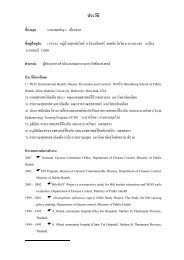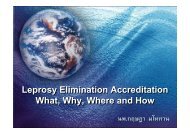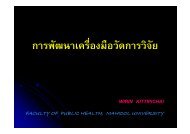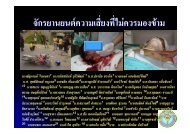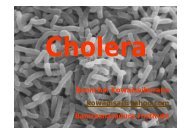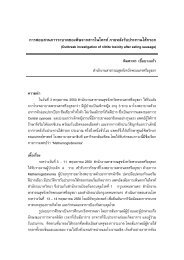MDR-TB
MDR-TB
MDR-TB
- No tags were found...
Create successful ePaper yourself
Turn your PDF publications into a flip-book with our unique Google optimized e-Paper software.
Microbial drugresistance: What dowe know about <strong>TB</strong>นพ.มนูญ ลีเชวงวงศรพ.วิชัยยุทธ
<strong>MDR</strong> and XDR-<strong>TB</strong>Health Care Worker’s Threatนพ.มนูญ ลีเชวงวงศประธานทุนวิจัยวัณโรคดื้อยา ศิริราชมูลนิธิในพระอุปถัมภ สมเด็จพระเจาพี่นางเธอเจาฟากัลยาณิวัฒนา กรมหลวงนราธิวาสราชนครินทรรพ.วิชัยยุทธ
สถานการณวัณโรคในปจจุบัน• ประเทศไทยมีผูปวยวัณโรค 130,000 คนเปนผูปวยรายใหม ปละ 90,000 คน• เสียชีวิตจากวัณโรค ปละ 12,000 คน• มีผูปวยวัณโรคเปนลําดับที่ 18 ของโลก• ผูปวยวัณโรครายใหมติดเชื้อเอดสรวมดวยรอยละ 13นสพ.ไทยรัฐ 26 ม.ค. 2550
Tuberculosis drug discovery/developmentPyrazinamideEthionamideStreptomycin IsoniazidPASThiacetazoneCycloserineKanamycin/amikacinRifampicinCapreomycinEMB1968196719661965195719561955195219461944
Frequency of mutation thatconfer drug resistance• 10 -6 for INH• 10 -6 for SM• 10 -8 for RIF• 10 -5 for EMB• 10 -14 for INH and RIFBasis for combination treatment
DiarylquinolineR 207910 (TMC 207)• Should combine with other newdrugs• monotherapy resistance emerged at1 in 10 8 comparable to rifampin• monotherapy is as active as triplecombination therapy I + R + Z• more active than R alone or I alone
Drug resistanceproblem is a manmade disease
Conceptually there are4 population of <strong>TB</strong>• Pan susceptible <strong>TB</strong>• Pre <strong>MDR</strong>-<strong>TB</strong>• <strong>MDR</strong>-<strong>TB</strong>• Post <strong>MDR</strong>-<strong>TB</strong> ( resist to allfirst line drugs and severeform, XDR-<strong>TB</strong> )
Increase in <strong>MDR</strong>-<strong>TB</strong> cases1. Amplification2. Transmission
Pansusceptible<strong>TB</strong>Poor Rx (I or RZ)Poor complianceIntolerancePre<strong>MDR</strong>-<strong>TB</strong>eg. resistto IRTransmission
Pre<strong>MDR</strong>-<strong>TB</strong>Amplification<strong>MDR</strong>-<strong>TB</strong>Transmissionresist to I Poor Rx (IRZ) resist toR Standard short I + Rcourse (IRZE)Poor complianceIntolerance
<strong>MDR</strong>-<strong>TB</strong>Definition : resistance to at least INHand RIFTypes :1 o <strong>MDR</strong>-<strong>TB</strong> = resistance in an individualwithout previous therapy(presumably transmitted)Acquired = resistance in an individualpreviously treated(presumably 2 o to erratic Rx)
<strong>MDR</strong>-<strong>TB</strong>resist toI + RAmplificationPost<strong>MDR</strong>-<strong>TB</strong>resist toTransmissionStandard shortcourse (IRZE)I + R + Z + E
We should strive forprompt detection andeffective treatment of <strong>MDR</strong>-<strong>TB</strong>, avoiding repeated courseof IRZE based retreatmentregimen
<strong>MDR</strong>-<strong>TB</strong>resistant2 nd line drugsXDR-<strong>TB</strong>transmissionto IRZESPoorcompliancetoxicitycostinterruption ofdrug supply
Revised WHO Case Definition forXDR-<strong>TB</strong> (Oct 10, 2006)Resistance to at least isoniazid andrifampicin (<strong>MDR</strong>) plus resistance tofluoroquinolones and one of thesecond-line injectable drugs(amikacin, kanamycin, orcapreomycin)
Risk of <strong>MDR</strong>-<strong>TB</strong> - improperuse of 1 st line drugsRisk of XDR-<strong>TB</strong> - improperuse of 2 nd line drugs
Incidence of <strong>MDR</strong>-<strong>TB</strong>in Thailand<strong>MDR</strong>-<strong>TB</strong>ผูปวยวัณโรคใหม 90,000 ราย/ปยอมเชื้อพบ 40,000 ราย/ป800 ราย/ปผูปวยเคยรักษา 10,000 ราย/ป 2,000 ราย/ป+2,800 ราย/ป
Prevalence of <strong>MDR</strong>-<strong>TB</strong>in Thailandรายใหม + รายเกาสะสม ~ 8,400 ราย/ป
Incidence of XDR-<strong>TB</strong>in ThailandIncidence of <strong>MDR</strong>-<strong>TB</strong>2,800 ราย/ปXDR-<strong>TB</strong> = 3% ของ <strong>MDR</strong>-<strong>TB</strong>Incidence of XDR-<strong>TB</strong>84 ราย/ป
Prevalence of XDR-<strong>TB</strong>in Thailand84*3 = 252 ราย/ป
วิวัฒนาการของกลยุทธตางๆ ในการรักษาวัณโรค โดยองคการอนามัยโลก• DOTS strategy (กลวิธี DOTS) 1994-1995• DOTS-Plus (DOTS + การเพาะเชื้อตรวจหาความไวตอยา)1998• DOTS-Plus for <strong>MDR</strong>-<strong>TB</strong> (DOTS plus สําหรับรักษาเชื้อวัณโรคดื้อยาหลายขนาน) 1999• Green Light Committee (คณะกรรมการไฟเขียว) 2000• Stop <strong>TB</strong> Partnership (พันธมิตรหยุดยั้งวัณโรค) 2001• Stop <strong>TB</strong> Strategy (กลวิธีหยุดยั้งวัณโรค) 2005• International Standards for Tuberculosis Care 2006
DOTS Strategyเนน• การกํากับการกินยา• คนหาโดยการยอมเชื้อในเสมหะ
Laboratory Diagnosis of <strong>TB</strong>1882 Recent PastRobert KochFirst to visualize M.tbthrough use ofspecial stainStill relying uponLJ Culture(4-6 weeks)Direct smear(> 10 4 AFB/ml)
Laboratory diagnosis of <strong>TB</strong>The Present• Improved recovery with Broth Culture Media– Bactec 460 <strong>TB</strong> - radiometric system– Bactec 9000 MB - fluorescent system– Mean time to detection in smear - positive specimensof 12.7 d. (range 7-21 d.)• Mycobacterial growth Indicator Tube (MGIT)– Mean time to detection in smear - positive specimensof 13.3 d (range 4-39 d.)
Laboratory diagnosis of <strong>TB</strong>The Present• Rapid identification of Culture Isolates byMolecular Methods• Accuprobe (Gen-Probe)– Chemiluminescent DNA probe assay– Highly specific– Identifies to level of “<strong>TB</strong>-complex”• Micro Seq (Applied biosystems)– Sequences portion of 16 s rDNA gene– Identifies to level of “<strong>TB</strong>-complex”– Time-consuming (< 24 h) and requires costlyinstrumentation
Laboratory Methods for MycobacteriumtuberculosisLJ Culture7H10 MiddlebrookLiquidRadiometricPCR Based0 2 4 6 8 10 12 14WeeksDrug Susceptibility Identification Isolation
Good mycobacteriologylaboratory is essential in<strong>TB</strong> control
DOTS Strategyเนน• การกํากับการกินยา• คนหาโดยการยอมเชื้อในเสมหะ
ประเทศไทยไมไดตั้งงบประมาณสําหรับการกํากับการกินยา สวนใหญDOT จึงทําโดยคนในครอบครัว
ผลการรักษาและบุคคลที่ทําหนาที่พี่เลี้ยงดูแลผูปวยวัณโรค (DOTS) จังหวัดตากป254425452546รักษาประสบความสําเร็จ59%57%63%พี่เลี้ยงดูแลกํากับการรักษาวัณโรคอสม. สมาชิก อื่น ๆครอบครัว52% 5%จนท.สาธารณสุข38%16%6%5%2%0%77%87%5%7%กิตติพัทธ เอี่ยมรอด และปราณี อายจุม. การควบคุมวัณโรคตามแนวทางการรักษาวัณโรคแบบมีพี่เลี้ยง (DOTS) จังหวัดตาก ปงบประมาณ 2544-2546,วารสารวัณโรค โรคทรวงอก และเวชบําบัดวิกฤต 2547: 193-198.
• DOT ในประเทศไทยสวนใหญทําโดยคนในครอบครัว ซึ่งอาจจะทําบางไมทําบาง ไมจริงจัง•ฝรั่งวิจารณวา เปน Sloppy DOTS(DOT แบบเหยาะแหยะ หรือหละหลวม)
ใน WHO Report 2006 : GlobalTuberculosis Control• ประเทศไทยไดทํา DOT ทั้งประเทศตั้งแตค.ศ. 2001• ในแงความสําเร็จของ DOT (รักษาใหหายขาดมากกวา 85%) ผลการรักษาของประเทศไทยไมเปนที่พอใจ และไมมีทีทาจะดีขึ้น(Poor treatment outcomes showing no signsof improving)
มาตรฐานในการดูแลรักษาวัณโรคนานาประเทศขององคการอนามัยโลกInternational Standards forTuberculosis Care (2006)WHO Websites (www.who.int/tb/en/)
High-quality DOTS expansionand enhancementการกํากับการกินยาที่มีคุณภาพสูงขึ้น และขยายครอบคลุม ใหกวางขวางและเขมขนยิ่งขึ้น
ในประเทศที่เจริญแลว• มีการตั้งงบประมาณในการกํากับการกินยา โดยเจาหนาที่สาธารณสุข• งบนี้สูงกวางบอื่น ๆ (คายา, คาหองปฏิบัติการ, คาแพทย พยาบาลฯลฯ)
ไทยติด 1 ใน 4 ประเทศคุมวัณโรคเหลวกรมควบคุมโรค กระทรวงสาธารณสุข 11 ม.ค. 2550• พบอัตราการปวยวัณโรคเพิ่มขึ้นอยางตอเนื่องตั้งแตป 2536-2547• ไทยเปน 1 ใน 4 ประเทศทั่วโลกที่ไมสามารถดําเนินตามแผนปองกันและควบคุมวัณโรคขององคการอนามัยโลก• วัณโรคมีปญหาการดื้อยามากขึ้นมติชน 12 ม.ค. 2550
Reasons for the developmentof <strong>MDR</strong>-<strong>TB</strong> : Bad <strong>TB</strong> control• Health care providers:Inadequate Regimens Rx• Drugs:inadequate supply/quality• Patients:inadequate drug intake
Health care providers :inadequate regimens Rx• Inappropriate guidelines• Non compliance with guidelines• Absence of guidelines• Poor training• No monitoring of treatment• Poorly organized or funded<strong>TB</strong> control programmes
Obsession with cuttingcosts leads to multi-drugresistance problem
ความพอเพียง หมายความวาประหยัดแตไมใชขี้เหนียว…..…….ทําอะไรดวยเหตุและผลพระราชดํารัส พระบาทสมเด็จพระเจาอยูหัว5 ธ.ค. 2543
Drugs : inadequatesupply/quality• Poor quality• Unavailability of certain drugs(stock outs or delivery disruptions)• Poor storage conditions• Wrong dose or combination
Patients : inadequatedrug intake• Poor adherence (or poor DOT)• Lack of information• Lack of money• Lack of transportation• Adverse effects• Social barriers• Malabsorption• Substance dependency disorders
ถาเปนไปไดควรจะทําการเพาะเชื้อและตรวจหาความไวตอยา เพราะทําใหแพทยทราบ1. เปนวัณโรคหรือไม2. ถาดื้อตอยา ดื้อตอยาอะไร- เปน <strong>MDR</strong>-<strong>TB</strong> หรือไม- ไวตอยาอะไร
ทุนวิจัยวัณโรคดื้อยาในพระอุปถัมภฯสมเด็จพระเจาพี่นางเธอเจาฟากัลยาณิวัฒนากรมหลวงนราธิวาสราชนครินทรทัศวรรณ ดวงสมร รศ.ดร. อังคณา ฉายประเสริฐนิภา สมบุญ รศ.นพ. เชิดศักดิ์ ธีระบุตรวิยะดา ยศปญญา อ.นพ. มนูญ ลีเชวงวงศปริญญา กรณิกา อ.ดร. เทิดศักดิ์ พราหมณะนันทนน้ําผึ้ง บุษยมาส ศ.คลินิก ปยะสกล สกลสัตยาทรสุนทรี ชุติมา
HCHCHRHRDirect Susceptibility Test : Susceptible <strong>TB</strong>
HHRHRHDirect Susceptibility Test : <strong>MDR</strong>-<strong>TB</strong>
Indirect susceptibility to first linedrugs (and 2 nd line drugs ifnecessary) on egg based media(Lowenstein-Jensen slants)
รพ.มะการักษ, จ.กาญจนบุรีป25442545254625472548พบเชื้อ(ราย)8589112102109ไมพบเชื้อ(ราย)3131589770<strong>TB</strong>นอกปอด(ราย)2431392824รวม(ราย)140151209227203<strong>MDR</strong>-<strong>TB</strong>(ราย)111616อัตราการดื้อยา(ราย)5.267.057.88Sputum AFB
ผลการศึกษาระบาดวิทยาโดยลายพิมพ DNA จาก“ทุนวิจัยวัณโรคดื้อยา”ในพระอุปถัมปสมเด็จพระเจาพี่นางเธอเจาฟากัลยาณิวัฒนา กรมหลวงนราธิวาสราชนครินทรโดยวิธีIS 6110-Southern blot hybridizationและ Spoligotypingยืนยันวามีการแพรระบาดของเชื้อวัณโรคดื้อยาหลายขนานในบางพื้นที่ของประเทศไทย
No.SpeciesIsolates1M.tbMt 143232M.tbDS 56321 2 3 4 5 6 7 8 9 10 11 12 13 14 15 16 17 18 19 20 2134M.tbM.tbDS 5996DS 61565M.tbDS 61576M.tbDS 64697M.tbDS 66928M.tbDS 66989M.tbDS 670110M.tbDS 685811M.tbMt 1432312M.tbDS 686013M.tbDS 696914M.tbDS 720115M.tbDS 721116M.tbDS 721217M.tbDS 728318M.tbDS 773519M.tbDS 873720M.tbDS 929121M.tbMt 14323
1 2 3 4 5 6 7 8No.SpeciesIsolates1M.tbMt 1432323456M.tbM.tbM.tbM.tbM.tbDS 9419DS 9429DS 9522DS 9633DS 98627M.tbDS 103078M.tbMt 14323
123456789101112131415161718192021222324252627282930Spoligotyping membrane DSNO.Lab No.FPNO.Lab No.FPNO.Lab No.FP1DS 5632BJ11DS 6969BJ21DS 9522BJ2DS 5996BJ12DS 7201Non BJ22DS 9633BJ3DS 6156BJ13DS 7211BJ23DS 9862BJ4DS 6157BJ14DS 7212BJ24DS 10307BJ5DS 6469BJ15DS 7283BJ25<strong>MDR</strong> 164BJ6DS 6692BJ16DS 7735BJ26<strong>MDR</strong> 165BJ7DS 6698BJ17DS 8737BJ27<strong>MDR</strong> 166BJ8DS 6701BJ18DS 9291BJ28<strong>MDR</strong> 167BJ9DS 6858BJ19DS 9419BJ29<strong>MDR</strong> 168Non BJ10DS 6860BJ20DS 9429BJ30<strong>MDR</strong> 169BJ
The changing face of <strong>MDR</strong>-<strong>TB</strong>strains “then and now”Then :Slow growing, attenuatedvirulenceNow :normal growth rates andvirulence (strain W, Beijing)
Susceptibility of <strong>MDR</strong>-<strong>TB</strong> againstsecond-line drugsSusceptible strainsSecond-linedrugsNew cases(n = 22)n (%)Previouslytreated cases(n = 49)n (%)History oftreatment notavailable(n = 28)n (%)Total(n = 99)n (%)Amikacin22 (100)44 (89.79)28 (100)94 (94.95)Kanamycin22 (100)44 (89.79)28 (100)94 (94.95)Ciprofloxacin22 (100)43 (87.76)25 (89.28)90 (90.91)Ofloxacin22 (100)43 (87.76)25 (89.28)90 (90.91)Ethionamide17 (77.27)36 (73.47)25 (89.28)78 (78.79)PAS20 (90.91)42 (85.71)23 (82.14)85 (85.86)Prammananan T et al, Int J Tuberc Lung Dis 2005;9(2):216-219.
• > 60% of <strong>MDR</strong>-<strong>TB</strong> also resist tostreptomycin• ~40% of <strong>MDR</strong>-<strong>TB</strong> resist to EMB• ~ 5% of <strong>MDR</strong>-<strong>TB</strong> resist toaminoglycoside ( kanamycinamikacin ) and fluoroquinolonei.e. XDR-<strong>TB</strong>
Management of patients withmulti drug-resistant <strong>MDR</strong>-<strong>TB</strong>• A single new drug should never beadded to a failing regimen• Employ at least three previouslyunused drugs to which there is in vitrosusceptibility. One of these should bea injectable agent• Should receive DOT• Resection of cavitary or badlydamaged lung
Approach to Treatment of <strong>MDR</strong>-<strong>TB</strong> > 4 active drugsGroup 1 : First line drugs, oral:H , R , E, ZGroup 2 : Injectables:S, KM, AKGroup 3 : Quinolones:CPX, OFX, LVX, MOXGroup 4 : Other second-lineBacteriostatic drugs: ETH, CS, PASAllpossible11Up to 3newCaminero JA, Int J Tuberc Lung dis 2006;10:829-837.
Fluoroquinolone antibioticsare the most important agentsin the management of <strong>MDR</strong>-<strong>TB</strong>cases.We must take steps tocontrol acquired resistance tothe FQNs
24 yr old F, new case of <strong>TB</strong>, HIV negativepresented with fever, cough, wt. Loss,hemoptysis, CXR - infiltrate with cavityAFB smear - positive 3 +Nov. 02Rx I + R + Z + E 10 days หยุด Rเนื่องจากแพ I + Z + E + SM. <strong>TB</strong> 6/3/03, resist to I, R, S26/5/03 sensitive to Kana,Etham, Oflox,Ethionamide, PAS
May, 03RxI + Z + EEthionamide + Oflox + PASทานยาไมสม่ําเสมอ ไมมีการกํากับการกินยาOct, 03 ไมยอมทานยา ใหแต INH อยางเดียว
M. <strong>TB</strong> resist to I, R, S, E, Oflox28/1/04 sensitive to Kana,Ethionamide, PAS15/7/04 resist to I, R, S, E,Oflox, EthionamideM. <strong>TB</strong> sensitive to Kana,PAS
Proposed empirical treatment for<strong>MDR</strong>-<strong>TB</strong> for those who failedcategory I4S 5 POEZ / 2 POEZ / 12 OEZ (P)while awaiting for drug susceptibilityChierakul N. Empiric treatment for <strong>MDR</strong>-<strong>TB</strong>.Siriraj Med J. 2006;58:1038.
60% of <strong>MDR</strong>-<strong>TB</strong> also resistto streptomycin
KZN Drug Resistant <strong>TB</strong> Survey1539 Isolates tested544 (35%) Cx +M. tuberculosis995 (65%) Cx negative221 (41%) <strong>MDR</strong>-<strong>TB</strong> 323 (59%) Susceptible53 (10%) XDR-<strong>TB</strong>(24% of <strong>MDR</strong>-<strong>TB</strong>)
Characteristics of KZNXDR-<strong>TB</strong> PatientsCharacteristics No (%)• No prior <strong>TB</strong> treatment 26 (51)• Proior <strong>TB</strong> treatment– Cure or completed treatment 14 (28)– Treatment Default or Failure 7 (14)• HIV-infected (44 tested) 44 (100)• Dead (includes 34% on ARV) 52 (98)• Identical M.Tb spoligotype 26/30
Molecular Typing Studies :Spoligotyping• 26 of 30 (87%) of XDR-<strong>TB</strong> isolatesfound to be genetically identical byspoligotyping• Includes HCWs (2 confirmed, 4suspected ; all died)Gandhi N et al : XVI International AIDS conference Toronto 2006
Implications• Gain in morbidity and mortality achieved byARV and <strong>TB</strong>-DOTS programs are threatenedby <strong>MDR</strong>-<strong>TB</strong> and XDR-<strong>TB</strong>• Improvement in infection control practicesand facilities are required to preventnosocomial transmission of <strong>TB</strong> including<strong>MDR</strong>-<strong>TB</strong>, XDR-<strong>TB</strong>• Resources are needed-<strong>TB</strong> control/DOTS, <strong>TB</strong>infection control, laboratory support(culture/susceptibility testing), 2 nd line drugsfor treatment of <strong>MDR</strong>-<strong>TB</strong> cases (DOTS-Plus)
สมเด็จพระมหิตลาธิเบศรอดุลยมหิตลาธิเบศรอดุลยเดชวิกรม เดชวิกรมพระบรมราชชนกพระบิดาแหงการแพทยและสาธารณสุขไทยไดทรงนิพนธบทความเกี่ยวกับวัณโรคในป พ.ศ.2463พระราชทานใหแกกรมสาธารณสุขเพื่อแจกจายใหแกประชาชน ใหรูวิธีปองกัน
พระองคทรงเนนที่ผูปวยมีหนาที่ปองกันไมใหแพรเชื้อไปติดคนอื่นเวลาไอ จาม ปดปากดวยผา มือเปอนตองลางมือวิธีการนี้ยังคงทันสมัย และสามารถใชปฏิบัติกับโรคติดเชื้อทางเดินหายใจทุกชนิดในปจจุบัน
โครงการรณรงคลดการแพรเชื้อทางเดินหายใจดวยการใสหนากากอนามัยและลางมือ
New drugs are needed totreat <strong>TB</strong>• Effective against <strong>MDR</strong> strain• Shortened duration oftherapy• Simplify <strong>TB</strong> treatment
Tuberculosis Drugsin Development (1)DrugResearch SponsorsIn Clinical TestingMoxifloxacin*CDC, OthersDiarylquinoline R207910 Johnson & JohnsonGatifloxacin*European Commission,Pyrrole LL-3858WHO/TDR +Lupin Ltd
Tuberculosis Drugsin Development (2)DrugResearch SponsorsIn Preclinical TestingNitroimidazole PA-824Diamine SQ109FAS 20013Chiron, <strong>TB</strong> AllianceSequella IncFasgen Inc*Already approved for other indications+Special Programme for Research and Training in Tropical DiseaseSource: <strong>TB</strong> Alliance
Nitroimidazole Derivatives:• Nitroimidazo-oxazole: OPC-67683Otsuka Co./Japan• Nitroiminazopyran PA-824
New generation ofRespiratory QuinoloneDC-159a• Daiichi Pharmaceutical Co.Japan
Risk Factors for M/XDR-<strong>TB</strong>• Any past history of tuberculosis, particularly ifthere has been erratic or incomplete treatment• Contact with a person with know drugresistance• Birth, travel or residence in an a highprevalence area of resistance• Persistently positive sputum smears after twomonths’ anti-tuberculosis treatment or• Positive sputum culture after three months’treatment
DOTS policya role in the evolution of XDR-<strong>TB</strong> ?• 2001 – the year South Africa implementedthe WHO’s DOTS strategy to combat <strong>TB</strong>• <strong>MDR</strong>-<strong>TB</strong> had already been circulating for atleast seven years in KZN• The evolution of the KZN XDR strainsuggests WHO strategy to treat alldiagnosed individuals with a fixedcombination of drugs without drugsusceptibility testing may have, in part, led tothe rapid evolution of XDR-<strong>TB</strong>CID 2007
“Amplifier effect”• Short-coursechemotherapy for patientsinfected with drugresistantstrains maycreate even moreresistance to the drugs inuse.
Anti tuberculosis drugresistance• Mono-resistance. resistance in vitroto one first-line antituberculosis drug.• Poly-resistance. resistance in vitro tomore than one first-lineantituberculosis drug,other than bothisoniazid and rifampicin.• <strong>MDR</strong>-<strong>TB</strong>. Resistance in vitro to atleast isoniazid and rifampicin.• Plus……..
Anti tuberculosis drugresistanceDefinition -agreed October 2006• XDR-<strong>TB</strong> = <strong>MDR</strong>-<strong>TB</strong> plusresistance to:–a fluoroquinolone and–>1 of 3 injectable second-linedrugs capreomycin, kanamycin,amikacin
Epidemiology
Global <strong>TB</strong> Estimates (2006)Estimated CasesEstimated DeathsAll Forms <strong>TB</strong> 8.8 million 1.6 Million<strong>MDR</strong><strong>TB</strong> 424,000 116,000XDR-<strong>TB</strong> 27,000 16,000
Countries with XDR-<strong>TB</strong> confirmed cases to dateBased on information provided to WHO Stop <strong>TB</strong> Department, July 2007 (n=37)The boundaries and names shown and the designations used on this map do not imply the expression of any opinionwhatsoever on the part of the WHO concerning the legal status of any country, territory, city or area or of itsauthorities, or concerning the delimitation of its frontiers or boundaries. Dotted lines on maps represent approximateborder lines for which there may not yet be full agreement. © WHO 2005. All rights reservedArgentinaArmeniaAzerbaijanBangladeshBrazilCanadaChileCzech RepublicEcuadorMexicoChina, Hong Kong SAREstoniaFranceLithuaniaNetherlandsNorwayPolandPeruPortugalRepublic of KoreaGeorgiaRomaniaGermanyRussian FederationIrelandSloveniaIslamic Republic of IranIsraelSouth AfricaItalySpainJapanSwedenUKLatviaThailandUSA
The bulk of the problem of XDR-<strong>TB</strong> resides in thosecountries with high numbers of <strong>MDR</strong>-<strong>TB</strong> and two thirds of<strong>MDR</strong> is in just 3 countries - China, India and the RussianFederation.
Extensive drug resistance <strong>TB</strong> / XDR-<strong>TB</strong>• XDR-<strong>TB</strong> documented in all regions of the world surveyed• National representative data showed that in USA 4% of<strong>MDR</strong>-<strong>TB</strong> were XDR-<strong>TB</strong>, while the figure in Latvia was 19%.CDC's Morbidity and Mortality Weekly Report, March2006• Joint WHO/CDC survey of 14 supranational <strong>TB</strong> referencelaboratories using samples from 48 countries
Factors in spread of<strong>MDR</strong> <strong>TB</strong>
50000Number of Droplets produced by DifferentAerosol Producing ManoeuvresNumber of droplets400003000020000100000Coughing Talking SingingLoudon RG, et al. Am Rev Respir Dis 1968;98:297-300
Diagnostics• Desperate need for modern, rapid M.<strong>TB</strong>diagnosis and drug susceptibility testing (firstand second line drugs, point of care)– Short term• Are there simple clinical and laboratory methods to predictdrug resistance?• Which rapid tests are most useful and practical in resourcelimited settings?• Expand rapid testing technologies be developed to includesecond line drugs?– Longer term• How to make widely available best rapid diagnostictechnologies and facilities?• How to train and retain laboratory personnel?
Urgent need tointerrupttransmission
How to interrupttransmission?–Primary nosocomial transmission critical- no orlimited infection control• Short term– focus on developing, implementing andmonitoring site appropriate infection controlstrategies in health care facilities• Long term– Vaccine– Alleviation of social and economic conditions andhealth disparities that breed both <strong>TB</strong> and HIV
Future projections Tugela FerryEffect of infection controlinterventions(2007-2012)• If no new interventions are introduced, a total of ~1,300 cases ofXDR tuberculosis predicted– Over half nosocomially transmitted.• Implementing and testing effectiveness of recommended infectioncontrol strategies critical• Combining available interventions could significantly avert newXDR <strong>TB</strong> infections– reduced hospitalization time, shift to outpatient therapy, rapid drugresistance testing, HIV treatment– improved ventilation, reasonable tuberculosis isolation facilities– mask use–Can decrease transmission by >50%
Treatment
Causes of inadequate antituberculosis treatment
Treatment Principles-<strong>MDR</strong>not so easy with XDR!• Single new drug should never be addedto a failing regimen; it may lead toacquired resistance to the added drug• Add at least three new drugs (e.g.,fluoroquinolone, ethionamide, and aninjectable drug: amikacin, kanamycin,or capreomycin) to the existing regimenbeing cognizant of the possibility of drugresistance
Predictors of Survival•Starting two drugs towhich the organismis susceptible withintwo weeks ofdiagnosis
Last chance saloon• Pulmonary resection - Local disease- Good C-P reserve- Mycobacterial burden low• Immune stimulants - M.vaccaeInterferon alpha Aerosol
XDR-<strong>TB</strong>Outbreaks
<strong>MDR</strong>/XDR - <strong>TB</strong> outbreaks• Factors responsible– Inadequate control programmes– Inadequate compliance– Infection control procedure breakdown– Immunosuppressed convergence– Index of suspicion low– Inadequate lab. communication– Infectiousness prolonged
XDR exposes the <strong>TB</strong> infection control neglectThe Tugela Ferry caseGhandi et al Lancet 2006; 368:1575-80.1539 isolates tested997 (65%) Cx- M<strong>TB</strong>542 (35%) Cx+ M<strong>TB</strong>323 (59%) Susceptible221(41%) <strong>MDR</strong><strong>TB</strong>53 (10%) XDR-<strong>TB</strong>(24% of <strong>MDR</strong>-<strong>TB</strong>)• All 44 tested for HIV were +• 52 XDR cases died• Median survival of 16 days• Typing identified 6-drug<strong>MDR</strong><strong>TB</strong> strain in Kwa-Zulu• Evidence for nosocomialtransmission• 51% no prior <strong>TB</strong> treatment• 67% prior hospitalization• 8 health workers died of XDR• By March 2007: 555 XDRcases in South Africa (267 inTugela Ferry)
RFLP pattern of F15/LAM4/KZN strain
Emergence of Multi/ExtensivelyDrug Resistant Tuberculosis :Prevention and Managementนพ.มนูญ ลีเชวงวงศประธานทุนวิจัยวัณโรคดื้อยา ศิริราชมูลนิธิในพระอุปถัมภ สมเด็จพระเจาพี่นางเธอเจาฟากัลยาณิวัฒนา กรมหลวงนราธิวาสราชนครินทรรพ.วิชัยยุทธ
<strong>MDR</strong> and XDR-<strong>TB</strong>How to manage?นพ.มนูญ ลีเชวงวงศประธานทุนวิจัยวัณโรคดื้อยา ศิริราชมูลนิธิในพระอุปถัมภ สมเด็จพระเจาพี่นางเธอเจาฟากัลยาณิวัฒนา กรมหลวงนราธิวาสราชนครินทรรพ.วิชัยยุทธ
16-year-old Thai femaleCC: productive cough for 2 weeksHer father and grandmother both diedfrom <strong>MDR</strong>-<strong>TB</strong> 1 year and 4 years agorespectivelyShe lived in the same house with bothof them.Their M.<strong>TB</strong> resisted to INH andrifampicin, susceptible to ethambutol,streptomycin, kanamycin, PAS,ethionamide and quinolone
Sputum AFB smear : +3CXR - cavity and reticulonodularinfiltrate in right upper lobe- infiltrates in left mid lung fieldSputum AFB C/S grew M.tuberculosisresisted to INH and RIF, susceptible toethambutol, PZA, streptomycin,kanamycin, PAS, ethionamide, ofloxacin,ciprofloxacin and moxifloxacin
She was treated withstreptomycin, ethambutol,PZA,ethionamide, cycloserineand moxifloxacin.Streptomycin IM wasdiscontinued after 6 months
37-year-old Thai maleCC: fever dry cough, 5 kg. weightloss, for 2 months, justdiscovered to be diabeticCXR - patchy infiltrates leftmiddle and lower lungfields
Bronchoscopy :small amount of secretion in left upper lobeBronchial washing :AFB smear +2Direct detection of M.<strong>TB</strong> complex DNA by PCR :positiveHe was started on I+R+Z+EHis cough subsided but recurred in 1 monthRepeated CXR showed worsening ofinfiltrates and new cavities seen
Bronchial washing grew M.<strong>TB</strong>susceptible to INH, ethambutol, PZA,streptomycin but resistant torifampicinRifampicin was discontinued. Hewas placed on I+E+Z+streptomycinand moxifloxacin. He graduallyimproved. Streptomycin IM wasdiscontinued after 6 months
24-year-old Thai maleCC: fever, 4 kg. weight loss and productivecough for 2 monthsHe was seen at another hospitalsputum AFB smear : +2CXR: large cavity in right upper lobe, diffusefibronodular infiltrate in right lung.He was treated with I+R+Z+E for 2 monthswithout any improvement. He wasswitched to I+R+E+moxifloxacin andstreptomycin 2 weeks ago.
Sputum AFB smear : +2Sputum AFB C/S grewM.tuberculosis resisted to INH,rifampicin, PZA, ethambutol andstreptomycin, susceptible tokanamycin, PAS, ethionamide,ofloxacin, ciprofloxacin andmoxifloxacin
He was treated with kanamycin,PAS, ethionamide, cycloserineand moxifloxacinKanamycin IM was discontinuedafter 6 months. He improvedgradually and gained 10 kg.
Drug susceptibleIsoniazidRifampicinPyrazinamideEthambutolMulti drugresistanceIsoniazidRifampicinPyrazinamideEthambutolAminoglycosideCapreomycinQuinolonesEthionamideCycloserinePASExtensive drugresistanceIsoniazidRifampicinPyrazinamideEthambutolAminoglycosideCapreomycinQuinolonesEthionamideCycloserinePASResistance by definitionResistance possible or likely
Clinical Development Pipeline-Phase I/IICompoundMoxifloxacinTMC 207OPC-67683PA 824LL-3858SQ-109DevelopmentstagePhase IIPhase IIPhase IIPhase IIPhase IPhase ISponsor/coordinatorBayer ; CDC/<strong>TB</strong>TC;John Hopkins U.;<strong>TB</strong> Alliance; U. Collegeof LondonTibotec(Johnson&Johnson)Otsuka PharmaceuticalCo.,Ltd.<strong>TB</strong> AllianceLupin Ltd.Sequella Inc.
Drug Resistant <strong>TB</strong> :Clinical Approachนพ.มนูญ ลีเชวงวงศประธานทุนวิจัยวัณโรคดื้อยา ศิริราชมูลนิธิในพระอุปถัมภ สมเด็จพระเจาพี่นางเธอเจาฟากัลยาณิวัฒนา กรมหลวงนราธิวาสราชนครินทรรพ.วิชัยยุทธ
Infraction control• อุปกรณระบายอากาศ เชน พัดลมระบายอากาศอุปกรณดูดอากาศออกภายนอก• High-Efficiency Particulate Air (HEPA) filter• Isolation room• Ventilation• การฆาเชื้อดวยแสงอุลตราไวโอเลต (UltravioletGermicidal Irradiation – UVGI)• Mask



